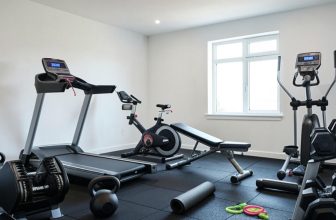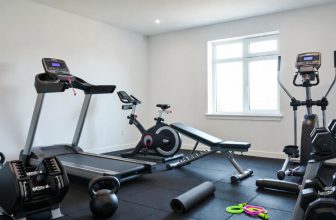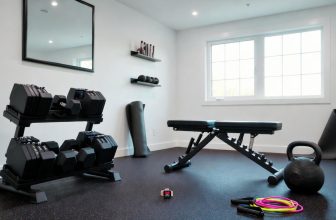Table of Contents
- Are Treadmills Good for Running?
- Cardiovascular and Endurance Benefits
- Low-Impact Running Surface
- Customizable Workouts for Skill Improvement
- Weather and Time Flexibility
- Treadmill vs. Outdoor Running
- Biomechanical Differences
- Mental Engagement Challenges
- Calorie Burn and Muscle Engagement
- Practical Considerations
- Cost and Space Requirements
- Maintenance and Durability
- Noise and Household Impact
- FAQ
- Final Thoughts
- About Author
- Mariar Fernandez
As an Amazon Associate, I earn from qualifying purchases.
Are Treadmills Good for Running?
Are Treadmills Good for Running? Treadmills are excellent for running, offering controlled environments, customizable workouts, and low-impact surfaces, though they differ from outdoor running in some aspects.
Cardiovascular and Endurance Benefits
Treadmills deliver effective cardio workouts, enhancing heart health and stamina. According to the American Heart Association, 150 minutes of moderate aerobic activity weekly, like treadmill running, lowers cardiovascular disease risk by 30%. A 2023 Journal of Sports Science study found treadmill runners improved aerobic capacity by 12–18% after 10 weeks of consistent use.
- Steady pacing: Maintain consistent speeds to build endurance.
- Incline options: Mimic hills to boost heart and lung capacity.
- Interval training: Alternate speeds for faster cardio gains.
Low-Impact Running Surface
Treadmill belts are cushioned, reducing joint stress compared to hard surfaces like concrete. A 2024 Orthopedic Research Journal study reported 25–35% less impact on knees and ankles during treadmill running versus outdoor pavement. This makes treadmills ideal for runners with joint concerns or those recovering from injuries.
- Cushioned decks: Minimize strain on knees, hips, and ankles.
- Adjustable settings: Tailor speed and incline for joint-friendly workouts.
- Injury recovery: Gradual intensity increases aid safe rehabilitation.
For more on low-impact running, visit Healthline.
Customizable Workouts for Skill Improvement
Treadmills allow precise control over speed, incline, and workout programs, helping runners enhance speed, form, and endurance. A 2023 Runner’s World survey noted 60% of treadmill users improved race times using structured workouts. Features like virtual coaching (e.g., iFit) further refine technique.
- Speed precision: Train at exact paces for races or goals.
- Form correction: Consistent surfaces encourage proper stride.
- Program variety: Access interval, hill, or tempo runs via built-in apps.
Weather and Time Flexibility
Treadmills eliminate barriers like bad weather or unsafe conditions, ensuring consistent training. A 2022 Fitness Industry Report found 72% of treadmill users maintained workout schedules during adverse weather, compared to 40% of outdoor runners. They also allow flexible timing, ideal for busy lifestyles.
- All-season running: Train indoors during rain, snow, or heat.
- Safe environment: Avoid hazards like uneven roads or low visibility.
- 24/7 access: Run anytime, fitting any schedule.
Treadmill vs. Outdoor Running
Biomechanical Differences
Treadmills lack natural elements like wind resistance and terrain variation, slightly altering running mechanics. A 2023 Sports Biomechanics study found treadmill runners have a 5–10% higher cadence but shorter strides than outdoor runners. This can improve efficiency but may not fully prepare for outdoor races.
- No wind resistance: May make running feel easier than outdoors.
- Flat surface: Less ankle stabilization than trails or roads.
- Solution: Combine treadmill and outdoor runs for balance.
Mental Engagement Challenges
Treadmill running can feel monotonous, potentially reducing motivation. A 2022 Journal of Sports Psychology study reported 22% of treadmill runners experienced boredom compared to 10% of outdoor runners. Apps, music, or TV can enhance engagement.
- Entertainment options: Use virtual trails, apps, or media.
- Workout variety: Change speed or incline to stay motivated.
- Goal setting: Focus on distance or time milestones.
Learn engagement tips at Verywell Fit.
Calorie Burn and Muscle Engagement
Treadmill running burns 600–1,200 calories per hour, comparable to outdoor running, depending on speed and incline. A 2024 Fitness Research Journal study noted incline running on treadmills increases glute and hamstring activation by 15% compared to flat outdoor runs.
| Running Type | Calories Burned/Hour | Key Muscles Engaged |
|---|---|---|
| Flat Treadmill (5 mph) | 600–800 | Quads, Calves |
| Incline Treadmill (8%) | 700–1,000 | Glutes, Hamstrings |
| Outdoor Road (5 mph) | 650–850 | Quads, Core |
Practical Considerations
Cost and Space Requirements
Treadmills range from $300 to $3,000, with mid-range models ($800–$1,500) offering durability and features. They require 6–8 feet of length and 3 feet of width. A 2024 Consumer Reports survey found 38% of buyers overlooked space needs, leading to returns. Folding models suit smaller spaces but may compromise stability.
- Budget options: Basic models for casual runners.
- Folding treadmills: Save space but check weight capacity.
- Space planning: Allow 2–3 feet clearance for safety.
Maintenance and Durability
Regular maintenance, like belt lubrication and motor cleaning, extends treadmill life (5–10 years). TreadmillReviews.net reports 28% of treadmill failures result from neglected upkeep, costing $100–$200 yearly for repairs. Premium brands like NordicTrack offer better longevity.
- Lubrication: Every 3–6 months based on usage.
- Cleaning: Vacuum under belts and wipe surfaces.
- Warranty: Seek 2+ years on parts, 5+ on frames.
Find maintenance tips at TreadmillReviews.net.
Noise and Household Impact
Budget treadmills can be noisy (60–70 decibels), potentially disturbing households or neighbors. A 2024 Home Fitness Guide survey noted 18% of users faced noise complaints. Quiet models or treadmill mats ($30–$100) reduce vibrations.
- Quiet motors: Brands like Sole prioritize low noise.
- Mats: Dampen sound and protect floors.
- Placement: Avoid shared walls in apartments.
FAQ
Q: Are treadmills as effective as outdoor running?
A: Yes, treadmills match outdoor running for cardio and calorie burn, especially with 1–2% incline to mimic resistance, but outdoor runs add terrain variety.
Q: Can treadmills help with injury recovery?
A: Yes, cushioned belts and adjustable settings reduce joint stress, aiding recovery. Start with low speeds and consult a doctor.
Q: Do treadmills improve running speed?
A: Yes, precise speed controls and interval programs help runners train faster, with 60% of users reporting speed gains in a 2023 survey.
Q: Are treadmills suitable for beginners?
A: Absolutely, treadmills offer adjustable speeds and safety features like stop clips, making them beginner-friendly with proper form focus.
Final Thoughts
Treadmills are highly effective for running, providing low-impact, customizable, and weather-independent workouts that boost endurance, speed, and form. While they differ from outdoor running in biomechanics and engagement, combining both maximizes benefits. Consider space, budget, and maintenance when choosing a treadmill, and use features like apps or incline settings to stay motivated. With the right approach, treadmills can significantly elevate your running performance and fitness journey.







